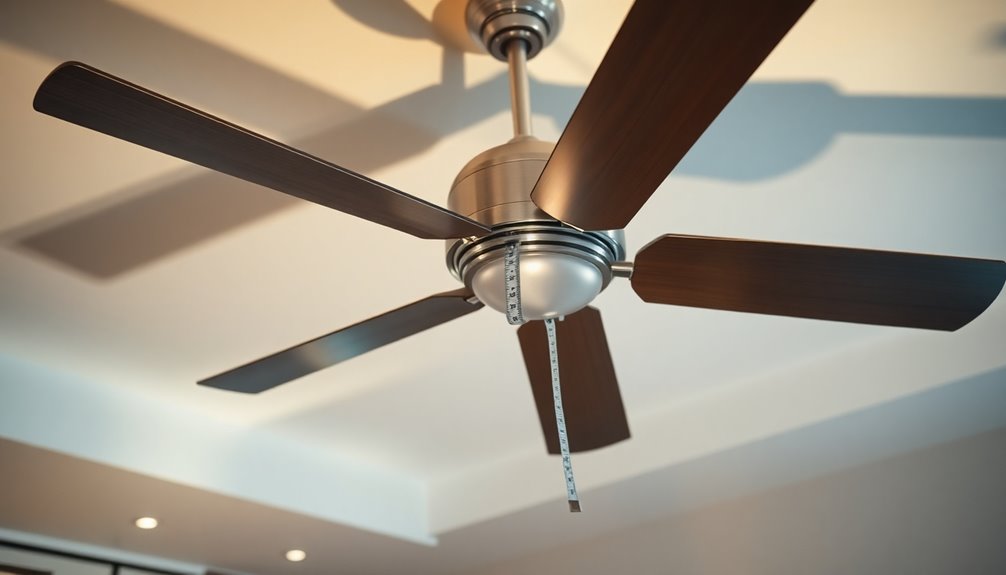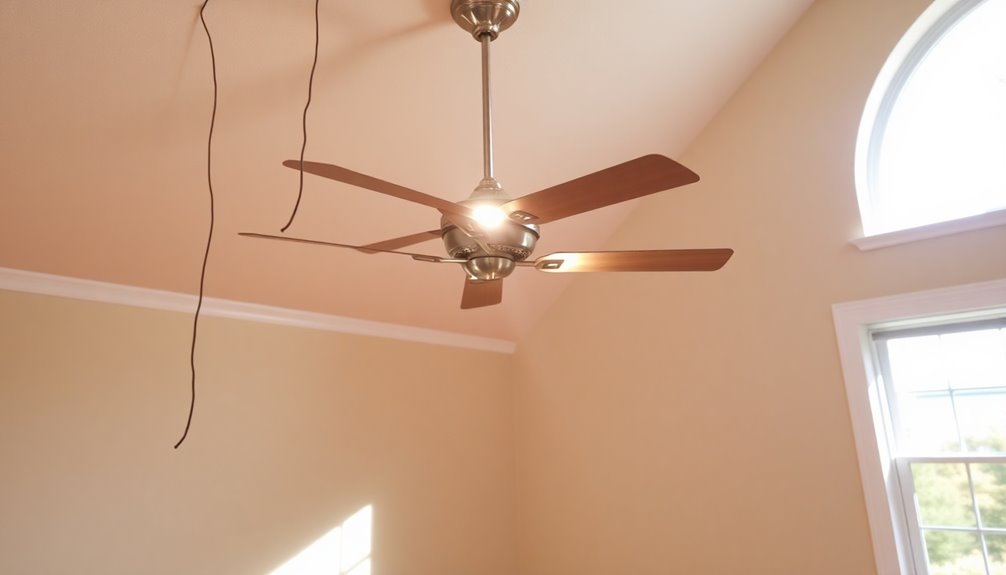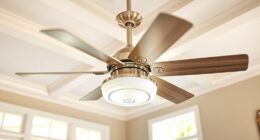To measure ceiling fans, start by knowing your room dimensions. Use a tape measure to find the length and width, calculating the area in square footage. Then, select the fan size based on this area—blade spans typically range from 29 to 60 inches, depending on the room's size. Ascertain you measure ceiling height as well, maintaining a minimum of 7 feet clearance from the floor to the fan blades. Don't forget about the necessary downrod length for higher ceilings. If you want to optimize your cooling, there are additional tips and considerations to explore.
Key Takeaways
- Measure the blade span from tip to tip to determine the fan size and ensure optimal airflow for the room's dimensions.
- Calculate the required downrod length by subtracting the fan housing height from the ceiling height to ensure proper positioning.
- Confirm that the fan is installed at least 7 feet above the floor for safety and effective circulation.
- Maintain 8-10 inches of clearance from the ceiling to the fan blades for optimal operation and airflow efficiency.
- Ensure a minimum distance of 18-24 inches between the fan blades and nearest wall to prevent airflow disruption.
Measuring Room Dimensions

When measuring room dimensions, start by grabbing a tape measure to get accurate lengths and widths from wall to wall. You'll want to measure the length and width of the room carefully, as these measurements are essential in calculating the area in square footage. For example, if your room measures 12 feet by 15 feet, you're looking at 180 square feet.
If you have an L-shaped room, divide it into two rectangles, calculate each area separately, and sum them for the total square footage.
Don't forget to measure the ceiling height, too. This information is critical in selecting the right ceiling fan size that can effectively circulate air throughout the space. Additionally, consider the best air flow ceiling fans to ensure you choose a model that enhances comfort in your room.
As you measure, consider the overall layout of the room, including any furniture and obstacles that could disrupt airflow. This guarantees you place the fan in a location that maximizes air circulation, avoiding areas where furniture might block the airflow.
Accurate measurements will help you make informed decisions, leading to a comfortable and well-ventilated room. So, take your time and measure everything carefully!
Selecting Fan Size

Choosing the right ceiling fan size is essential for achieving suitable airflow and comfort in your space. The blade span, which is the distance from one blade tip to the opposite tip, should align with your room's square footage for best air circulation.
For rooms up to 75 square feet, a fan with a blade span of 29-36 inches works best. If your space ranges from 76-144 square feet, opt for a fan size of 36-44 inches.
For larger rooms between 145 and 225 square feet, select a fan with a blade span of 44-54 inches. In spaces of 226-400 square feet, a fan with a span of 52-60 inches is suitable. If your room exceeds 400 square feet, consider multiple fans or an extra-large fan with a blade span of 65 inches or more.
When installing a ceiling fan, don't forget to check for clearance above and the appropriate downrod length for your ceiling height.
Also, think about the fan layout and furniture placement to guarantee functional and aesthetic appeal. This way, you can maximize airflow and enhance your overall comfort.
Measuring Fan Dimensions

Measuring ceiling fan dimensions accurately is crucial for guaranteeing proper fit and performance in your space. Start by determining the blade span, which is the distance from the tip of one blade to the tip of the opposing blade. For even-numbered blades, this measurement is straightforward. If you have an odd number of blades, measure from the tip of the blade to the center and then double it.
Here are some key measurements to take into account:
- Blade Span: Standard spans range from 29 to 60 inches, with larger fans suitable for bigger rooms to optimize air circulation.
- Ceiling Height: Measure this to guarantee your fan is high enough for safety and airflow.
- Downrod Length: Subtract the height of the fan housing (usually 8-12 inches) from the ceiling height to find the right downrod length.
- Clearance: Maintain a minimum of 7 feet from the floor to the bottom of the fan blades.
Clearance and Height Requirements

After determining the dimensions of your ceiling fan, it's important to evaluate clearance and height requirements for ideal performance. To guarantee safety and maximum airflow, install your ceiling fan at least 7 feet above the floor. This height not only protects you from accidental contact but also enhances air circulation.
For effective operation, maintain a minimum clearance of 8-10 inches from the ceiling to the fan blades. If your ceiling height is lower than 8 feet, consider using low-profile or flush mount fans. These options maximize headroom while guaranteeing safety and comfort.
Additionally, keep an 18-24 inch distance between the fan blades and the nearest wall to improve airflow and prevent obstructions. If your ceiling height exceeds 9 feet, a downrod is necessary to position the fan at the appropriate height for efficient air movement.
Measuring these factors correctly will enhance the functionality of your ceiling fans, guaranteeing they operate effectively while keeping safety a priority.
Installation Tips and Considerations

When it comes to installing your ceiling fan, paying attention to the details can make a significant difference in its performance and safety. Follow these installation tips to guarantee best results:
- Check ceiling height: Maintain a minimum clearance of 7 feet from the floor to the fan blades. This helps prevent accidents and improves air circulation.
- Choose the right mount: For ceilings higher than 9 feet, use a downrod to lower the fan. Adjust the downrod length based on the total ceiling height for effective airflow.
- Consider angled ceilings: If your ceiling is greater than 32 degrees, you'll need a slope mount adapter to guarantee proper alignment and stability of the fan.
- Identify obstacles: Be mindful of nearby obstacles like cabinets, beams, and doors. This prevents airflow disruption and maximizes fan performance.
Frequently Asked Questions
What Does 48 Inch Fan Mean?
A 48-inch fan means the diameter of its blades measures 48 inches from tip to tip.
This size is perfect for medium-sized rooms, typically between 144 and 225 square feet. It offers a nice balance of airflow, ensuring your space stays comfortable without being overwhelming.
When you install the fan, make sure there's at least 8-10 inches of clearance from the ceiling for ideal performance and airflow efficiency.
Is a 52 Inch Fan Too Big for a 10X10 Room?
Imagine a gentle breeze dancing through your room, perfectly balanced and soothing.
A 52-inch fan is like a giant in a cozy cottage—it can overwhelm a 10×10 space. You'll likely find the airflow too intense, leaving you feeling as if you're caught in a whirlwind.
Instead, opt for a smaller fan, ideally between 36 to 44 inches, to create a harmonious atmosphere without sacrificing comfort or inviting noise into your sanctuary.
How Do You Know What Size Ceiling Fan to Buy?
To know what size ceiling fan to buy, start by measuring your room's square footage. Multiply the length by the width.
For smaller rooms, like those under 75 sq ft, choose fans with a blade span of 29-36 inches. As the room size increases, so should the fan size.
Don't forget to take into account ceiling height and guarantee proper clearance for ideal airflow and safety. This way, you'll enjoy a comfortable environment.
What Size Room Is a 54 Inch Ceiling Fan?
A 54-inch ceiling fan's perfect for a room like a gentle breeze in a cozy café.
It efficiently cools spaces between 225 and 400 square feet, making it ideal for medium to large areas.
For maximum airflow, verify your ceiling's at least 8 feet high, keeping the fan blades 7 feet above the floor.
If your room exceeds 400 square feet, consider adding another fan or choosing a larger model for better circulation.
Conclusion
Now that you've learned how to measure for a ceiling fan, you're one step closer to transforming your space. Imagine the cool breeze on a hot day, the perfect fan quietly spinning above you. But wait—what happens if you choose the wrong size? It could disrupt the entire vibe of your room. Don't rush your decision; take your time, double-check your measurements, and guarantee you've got everything just right. Your comfort depends on it!









